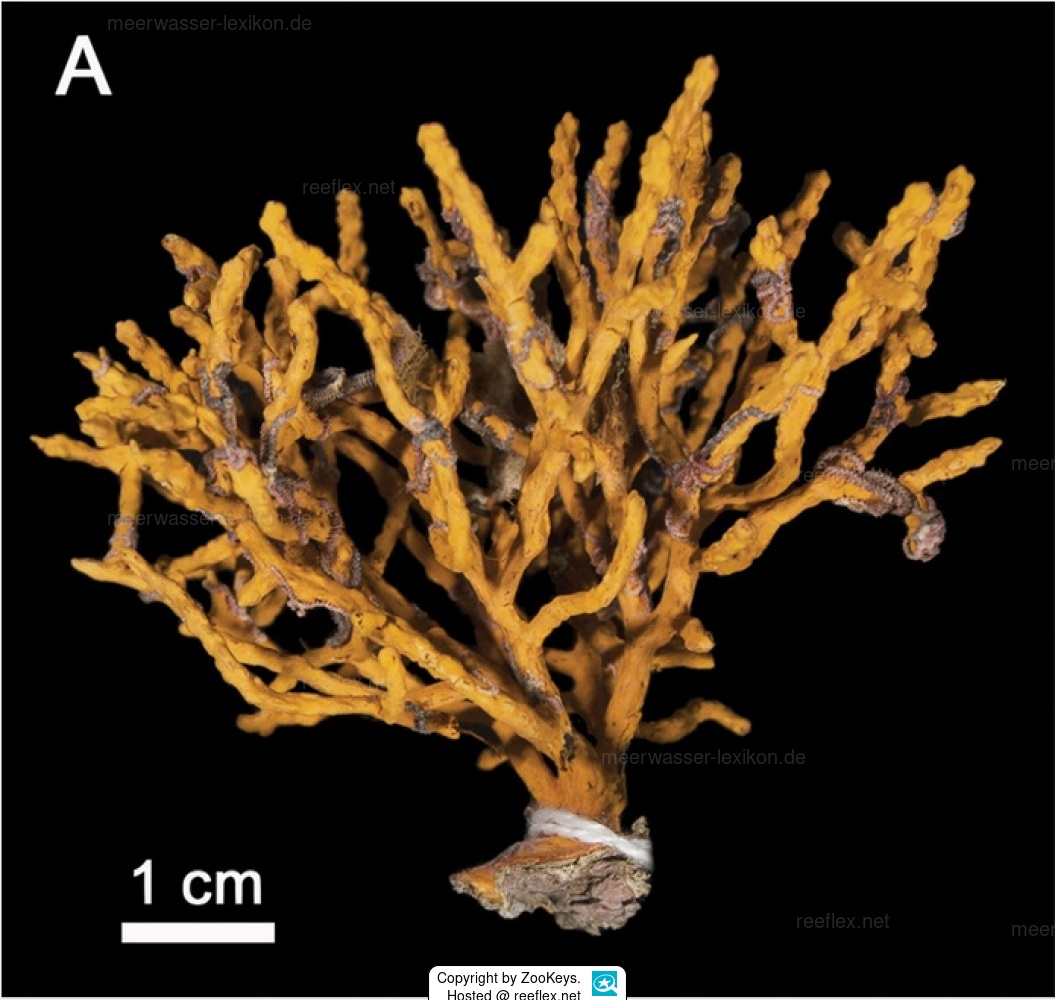Info
The island of San Pedro Mártir is a UNESCO biosphere reserve "Islas del Golfo de California".
Here the holotype was discovered in a water depth of only one metre.
The micro-endemic Leptogorgia martirensis sp. nov. was only found in rocky, shallow waters (up to 10 m depth) and in low abundance on the islands of San Pedro Mártir and San Esteban, Sonora.
Leptogorgia martirensis is a yellow colony with bushy and dense growth with multiple and irregular brownish lines.
The colony ((Fig. 4A) was 6.1 cm long and 8.1 cm wide and had four main branches up to 11 mm long and 3 mm in diameter.
The main branches subdivided into several secondary branches (up to 31 mm long, 2 mm in diameter). The terminal branches were flat and short (12 mm long, 2 mm wide) with pointed ends.
The general pattern of branching upwards is laterally at a 45° angle.
The polyp mounds are oval and prominent, forming one or two rows on each side of the branches with 0.5 mm height, 2 mm length and 1 mm width with elongated calyxes.
The colony has several specimens of unidentified dried ophiuroids (< 2 mm mouth disc diameter) attached to the twigs (Fig. 4A).
The micro-endemic Leptogorgia martirensis sp. nov. has only been recorded in rocky, shallow waters (up to 10 m depth) and in low abundance on the islands of San Pedro Mártir and San Esteban, Sonora.
The islands are located in the northern Gulf of California (as part of the Cortez Province according to Brusca and Wallerstein 1979, Hasting 2000) and are the most isolated islands in the Gulf.
The Cortez Province is associated with the lowest winter sea surface temperature the greatest annual variations (15°C - 30°C) and high marine productivity, and hosts a unique macroinvertebrate community dominated by endemic octocorals of the genus Muricea.
Leptogorgia martirensis shares its habitat with Muricea austera Verrill, 1869, Muricea plantaginea (Valenciennes, 1846), Psammogorgia teres Verrill, 1868, and Eugorgia excelsa Verrill, 1868.
Leptogorgia martirensis takes its name from the site where it was found on the island of San Pedro Mártir.
Source:
https://zookeys.pensoft.net/article/50619/list/8/
Hernández O, Gomez-Gutiérrez J, Sánchez C (2021)
Three new species of the sea fan genus Leptogorgia (Octocorallia, Gorgoniidae) from the Gulf of California, Mexico.
ZooKeys 1017: 1-20. https://doi.org/10.3897/zookeys.1017.50619
This is an open access article distributed under the terms of the Creative Commons Attribution License (CC BY 4.0), which permits unrestricted use, distribution, and reproduction in any medium, provided the original author and source are credited.







 ZooKeys
ZooKeys





























